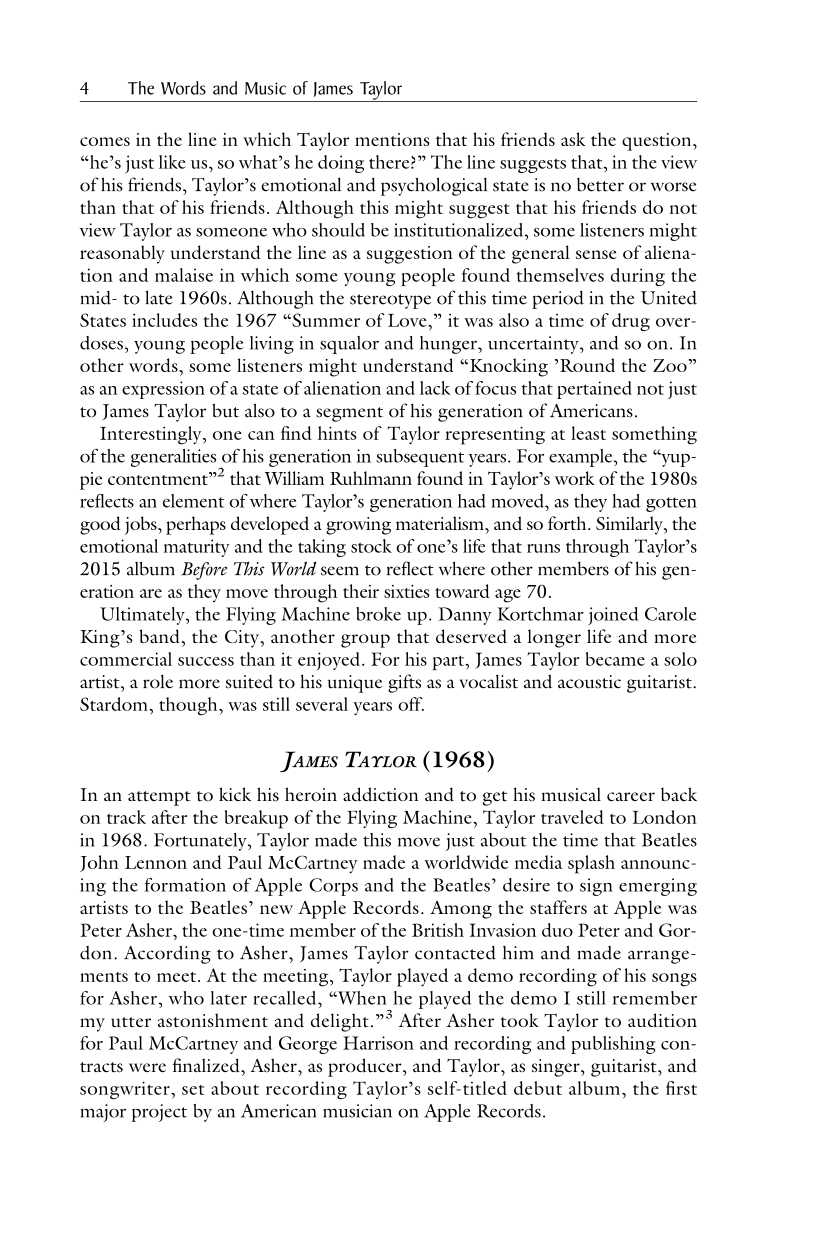comes in the line in which Taylor mentions that his friends ask the question,
“he’s just like us, so what’s he doing there?” The line suggests that, in the view
of his friends, Taylor’s emotional and psychological state is no better or worse
than that of his friends. Although this might suggest that his friends do not
view Taylor as someone who should be institutionalized, some listeners might
reasonably understand the line as a suggestion of the general sense of aliena-
tion and malaise in which some young people found themselves during the
mid- to late 1960s. Although the stereotype of this time period in the United
States includes the 1967 “Summer of Love,” it was also a time of drug over-
doses, young people living in squalor and hunger, uncertainty, and so on. In
other words, some listeners might understand “Knocking ’Round the Zoo”
as an expression of a state of alienation and lack of focus that pertained not just
to James Taylor but also to a segment of his generation of Americans.
Interestingly, one can find hints of Taylor representing at least something
of the generalities of his generation in subsequent years. For example, the “yup-
pie
contentment”2
that William Ruhlmann found in Taylor’s work of the 1980s
reflects an element of where Taylor’s generation had moved, as they had gotten
good jobs, perhaps developed a growing materialism, and so forth. Similarly, the
emotional maturity and the taking stock of one’s life that runs through Taylor’s
2015 album Before This World seem to reflect where other members of his gen-
eration are as they move through their sixties toward age 70.
Ultimately, the Flying Machine broke up. Danny Kortchmar joined Carole
King’s band, the City, another group that deserved a longer life and more
commercial success than it enjoyed. For his part, James Taylor became a solo
artist, a role more suited to his unique gifts as a vocalist and acoustic guitarist.
Stardom, though, was still several years off.
JAMES TAYLOR (1968)
In an attempt to kick his heroin addiction and to get his musical career back
on track after the breakup of the Flying Machine, Taylor traveled to London
in 1968. Fortunately, Taylor made this move just about the time that Beatles
John Lennon and Paul McCartney made a worldwide media splash announc-
ing the formation of Apple Corps and the Beatles’ desire to sign emerging
artists to the Beatles’ new Apple Records. Among the staffers at Apple was
Peter Asher, the one-time member of the British Invasion duo Peter and Gor-
don. According to Asher, James Taylor contacted him and made arrange-
ments to meet. At the meeting, Taylor played a demo recording of his songs
for Asher, who later recalled, “When he played the demo I still remember
my utter astonishment and
delight.”3
After Asher took Taylor to audition
for Paul McCartney and George Harrison and recording and publishing con-
tracts were finalized, Asher, as producer, and Taylor, as singer, guitarist, and
songwriter, set about recording Taylor’s self-titled debut album, the first
major project by an American musician on Apple Records.
4 The Words and Music of James Taylor









































































































































































